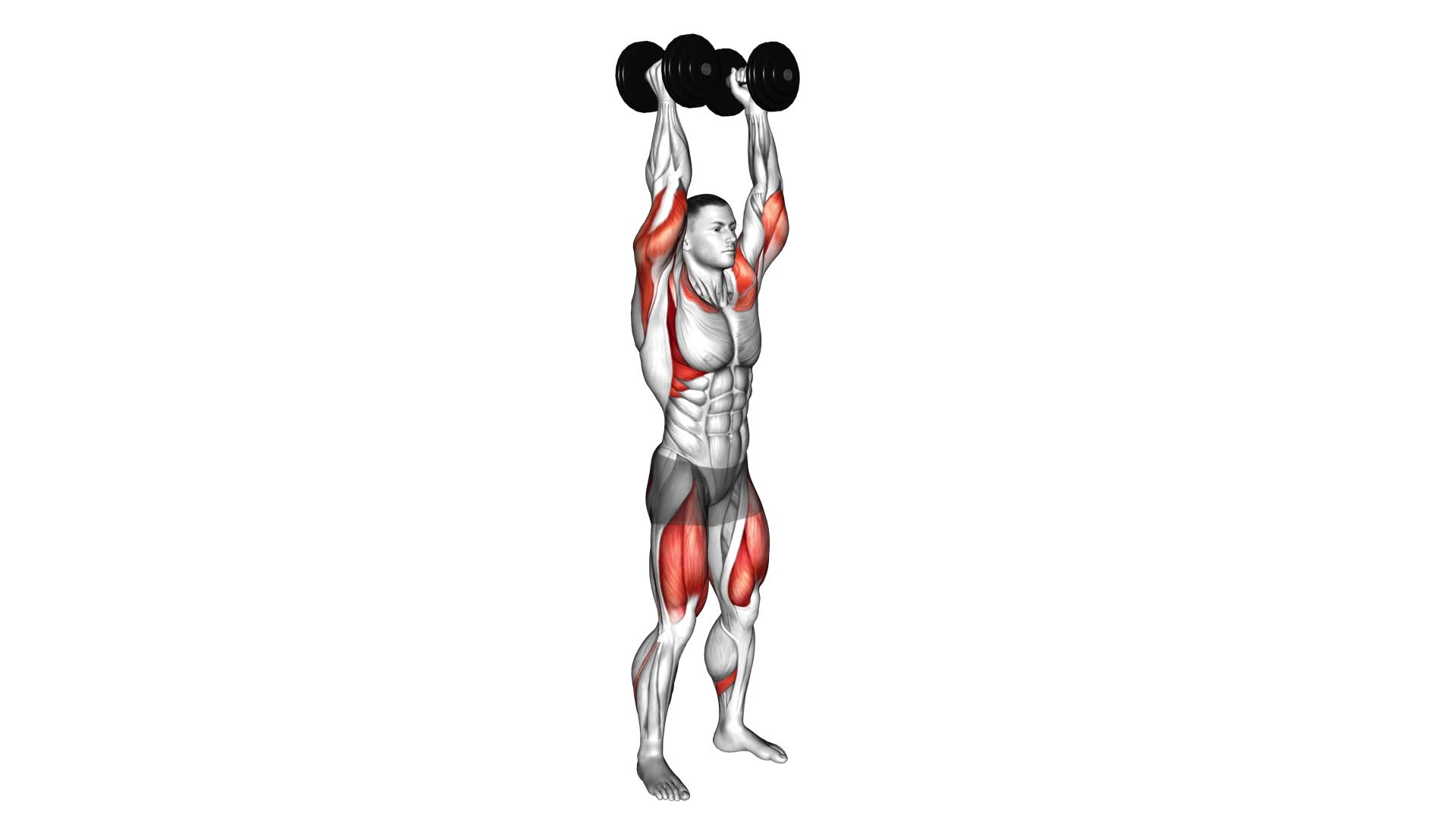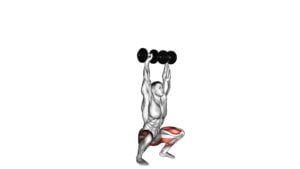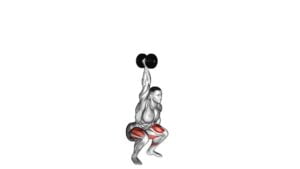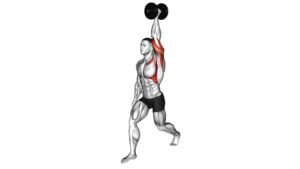Dumbbell Squat to Overhead Press – Video Exercise Guide & Tips

Are you looking for an efficient full-body exercise that targets multiple muscle groups? Look no further than the dumbbell squat to overhead press.
Watch This Exercise Video
This dynamic movement combines the power of a squat with the strength of an overhead press, providing a challenging workout for your legs, glutes, shoulders, and core.
In this article, we will guide you through proper form, weight selection, and modifications for all fitness levels. Get ready to elevate your fitness routine with this effective exercise.
Key Takeaways
- Dumbbell Squat to Overhead Press targets multiple muscle groups simultaneously, including quadriceps, hamstrings, glutes, shoulders, and triceps.
- Proper form is essential, including adjusting the weight of dumbbells, modifying the depth of squat, and maintaining a neutral spine throughout the movement.
- Gradually increasing weight as strength improves and focusing on control and stability during the exercise is important.
- Incorrect form can lead to strains or pulled muscles, so it is crucial to start with lighter weights and gradually progress while maintaining proper alignment and technique.
Benefits of the Dumbbell Squat to Overhead Press
You will experience increased strength and muscle development when you perform the dumbbell squat to overhead press. This compound exercise targets multiple muscle groups simultaneously, making it an efficient way to maximize your workout benefits. The dumbbell squat to overhead press primarily engages your quadriceps, hamstrings, glutes, shoulders, and triceps. By incorporating this exercise into your routine, you can enhance your lower body strength and upper body power.
To modify the dumbbell squat to overhead press, you can adjust the weight of the dumbbells or the depth of your squat. If you're a beginner, start with lighter dumbbells and gradually increase the weight as you build strength. You can also perform a partial squat if you find it challenging to go all the way down. Additionally, if you have any knee or lower back issues, it's important to consult with a fitness professional to ensure proper form and avoid any potential injuries.
Maximizing the benefits of the dumbbell squat to overhead press requires proper technique and form. Begin by standing with your feet shoulder-width apart, holding a dumbbell in each hand at shoulder level. Lower yourself into a squat position, keeping your chest up and your knees behind your toes. As you stand back up, push through your heels and simultaneously press the dumbbells overhead, fully extending your arms. Remember to engage your core throughout the movement to maintain stability and control.
Incorporating the dumbbell squat to overhead press into your workout routine can lead to increased strength, muscle development, and overall fitness. By utilizing dumbbell squat modifications and focusing on proper form, you can maximize the benefits of this compound exercise.
Proper Form and Technique
To ensure proper form and technique during the dumbbell squat to overhead press exercise, it's important to focus on body alignment. Keep your feet shoulder-width apart, knees aligned with your toes, and maintain a neutral spine throughout the movement.
Additionally, breathing techniques play a crucial role in maintaining stability. Remember to exhale as you push the dumbbells overhead and inhale as you lower them back down.
Lastly, be aware of common form mistakes such as rounding your back or using too much momentum. By paying attention to these points, you can maximize the effectiveness of this exercise and minimize the risk of injury.
Body Alignment During Exercise
Maintain proper body alignment throughout the dumbbell squat to overhead press exercise for optimal form and technique. Correct body posture is essential to ensure that you engage the correct muscles and avoid injury.
Stand with your feet shoulder-width apart and your toes slightly turned out. Keep your chest lifted, shoulders back and down, and your core engaged.
As you lower into the squat, make sure your knees track over your toes and your weight is evenly distributed through your heels.
When performing the overhead press, maintain a straight spine, with your head aligned with your spine and your shoulders relaxed.
Breathing Techniques for Stability
To maintain stability and proper form during the dumbbell squat to overhead press, focus on your breathing technique.
Proper breathing techniques can help stabilize your core and improve your overall stability during the exercise. When performing the squat, inhale deeply as you lower your body down, and exhale forcefully as you push through your heels to stand back up. This helps engage your core muscles and maintain a strong and stable posture.
As you transition into the overhead press, inhale before you begin the movement, and exhale as you press the dumbbells overhead. This coordinated breathing pattern ensures that you maintain stability and control throughout the exercise, allowing you to maximize the benefits and minimize the risk of injury.
Remember to always engage your core during the entire exercise to maintain stability and proper form.
Common Form Mistakes
One common form mistake to avoid during the dumbbell squat to overhead press is allowing your knees to collapse inward. This can put unnecessary strain on your knees and decrease the effectiveness of the exercise. To ensure proper form and technique, focus on maintaining proper weight distribution throughout the movement.
Here are some tips to help you avoid common form mistakes:
- Keep your knees aligned with your toes throughout the squat and press.
- Engage your core and keep your back straight throughout the exercise.
- Maintain a neutral spine position to avoid unnecessary stress on your lower back.
- If you're a beginner, start with lighter weights or modify the exercise by performing a bodyweight squat to overhead press until you feel comfortable with the movement.
Choosing the Right Dumbbell Weight
You should choose a dumbbell weight that feels challenging but allows you to maintain proper form throughout the exercise. Proper technique is essential to ensure that you're targeting the correct muscles and reducing the risk of injury. When selecting the right weight, it's crucial to find a balance between pushing yourself and maintaining proper form.
To determine the proper weight selection, start by assessing your current fitness level and strength. If you're a beginner, it's recommended to start with lighter dumbbells to focus on mastering the proper technique. As you become more comfortable and proficient, gradually increase the weight to continue challenging yourself.
On the other hand, if you're more experienced and have a higher fitness level, you may need to start with heavier dumbbells. However, it's still important to prioritize maintaining proper form over lifting heavy weights. Remember that using improper form can lead to injury and diminish the effectiveness of the exercise.
During the dumbbell squat to overhead press exercise, you should be able to perform the movements with control and stability. If you find yourself struggling to complete the exercise without compromising your form, it's a sign that the weight you're using is too heavy. On the other hand, if you're breezing through the exercise without feeling challenged, it may be time to increase the weight.
Common Mistakes to Avoid
When performing the dumbbell squat to overhead press, it's important to be aware of common mistakes that can hinder your progress and potentially lead to injury.
One common mistake is incorrect form, which can put unnecessary strain on your joints and muscles.
Another mistake to avoid is improper weight distribution, as this can throw off your balance and compromise the effectiveness of the exercise.
Lastly, overextending without control is a common error that can result in loss of stability and potential injury.
Incorrect Form Dangers
To avoid potential injuries and maximize the effectiveness of the dumbbell squat to overhead press exercise, it's important to be mindful of the correct form and avoid common mistakes. Incorrect form can lead to various dangers and increase the risk of injuries.
Here are some key dangers of incorrect form and injury risks to be aware of:
- Straining your lower back: Arching your back or leaning too far forward during the squat can put excessive strain on your lower back, leading to pain or injury.
- Overextending your knees: Locking your knees at the top of the squat can cause unnecessary stress on the joint, potentially leading to knee pain or damage.
- Using momentum instead of muscle power: Swinging the weights or relying on momentum rather than using your muscles to lift can increase the risk of strains or pulled muscles.
- Neglecting proper alignment: Failing to maintain proper alignment throughout the exercise, such as keeping your knees in line with your toes, can result in joint discomfort or injury.
Weight Distribution Errors
Maintaining proper weight distribution is crucial to avoid common mistakes and ensure the effectiveness of the dumbbell squat to overhead press exercise.
One of the most common errors is using improper technique when it comes to weight placement. It's important to evenly distribute the weight between both feet during the squat phase of the exercise. Placing too much weight on one foot can lead to imbalances and potential injuries.
Additionally, during the overhead press phase, it's essential to keep the weight centered and balanced above your head. Leaning too far forward or backward can strain your muscles and compromise the effectiveness of the exercise.
Overextending Without Control
Avoid overextending without control to prevent potential injuries and maintain proper form during the dumbbell squat to overhead press exercise. Overextending puts excessive strain on your joints and can lead to muscle imbalances and pain. To avoid these risks and ensure injury prevention, follow these tips:
- Maintain a neutral spine throughout the exercise to protect your lower back.
- Control the movement by engaging your core and using a slow and controlled tempo.
- Avoid locking out your knees and elbows at the top of the movement to prevent joint hyperextension.
- Focus on the mind-muscle connection and listen to your body's limits to avoid overextending beyond your comfortable range of motion.
Modifications for Different Fitness Levels
Choose appropriate modifications for your fitness level when performing the Dumbbell Squat to Overhead Press exercise.
Whether you're a beginner or an advanced individual, there are modifications and variations available to suit your needs.
For beginners, it's important to start with lighter weights and focus on proper form and technique. Begin by performing the exercise without weights, using just your body weight. This will help you develop the necessary strength and stability before adding additional resistance. As you progress, you can gradually introduce light dumbbells, focusing on maintaining proper alignment and control throughout the movement.
For advanced individuals, there are several variations that can increase the intensity of the exercise. One option is to use heavier dumbbells or increase the number of repetitions. This will challenge your muscles and help to build strength and endurance. Another option is to incorporate a jump squat into the movement, which adds an explosive element and engages more muscles. Additionally, you can try performing the exercise on an unstable surface, such as a balance board or a Bosu ball, to further challenge your core stability and balance.
Tips for Getting the Most Out of the Exercise
To get the most out of the exercise, focus on controlling your breathing throughout the movement. This will help you maintain proper form and maximize your results.
Here are some tips for getting stronger and increasing the intensity of the dumbbell squat to overhead press:
- Start with a weight that challenges you, but allows you to maintain good form. Gradually increase the weight as you get stronger.
- Engage your core muscles throughout the exercise. This will help stabilize your body and allow you to lift heavier weights.
- Keep your knees aligned with your toes during the squat portion of the movement. This will help prevent injury and ensure that you're targeting the correct muscles.
- As you press the dumbbells overhead, fully extend your arms and engage your shoulder muscles. This will increase the intensity of the exercise and help you build strength in your upper body.
Frequently Asked Questions
How Many Sets and Repetitions Should I Do for the Dumbbell Squat to Overhead Press?
To determine the number of sets and repetitions for the dumbbell squat to overhead press, it's important to consider your fitness goals and current fitness level. Adding this exercise to your routine can provide numerous benefits, such as improving strength and coordination.
To perform it correctly, start by holding dumbbells at shoulder level, squat down, then press the weights overhead as you stand up.
Consult with a fitness professional for personalized recommendations on sets and reps.
Can I Substitute the Dumbbells With a Barbell for This Exercise?
Yes, you can substitute the dumbbells with a barbell for the dumbbell squat to overhead press exercise. Using a barbell can be just as effective as using dumbbells, as it allows you to work multiple muscle groups at once.
It also provides a greater challenge to your stability and core strength. However, be sure to use proper form and start with a lighter weight to ensure proper technique and prevent injury.
Is It Necessary to Warm up Before Performing the Dumbbell Squat to Overhead Press?
It's important to warm up before performing any exercise, including the dumbbell squat to overhead press. Warming up helps increase blood flow, warm up your muscles, and reduce the risk of injury.
It's recommended to do some light cardio and dynamic stretching before starting the exercise. Beginners can modify the dumbbell squat to overhead press by using lighter weights or starting with bodyweight squats and overhead presses.
Always listen to your body and adjust the exercise accordingly.
Can I Perform This Exercise if I Have Knee or Shoulder Injuries?
If you have knee or shoulder injuries, it's important to modify the dumbbell squat to overhead press exercise. Consult with a healthcare professional or a qualified trainer who can guide you on appropriate modifications.
It's crucial to prioritize your safety and avoid exacerbating any existing injuries. Gradually increasing the intensity of the exercise can be done for rehabilitation purposes, but it should be done under professional supervision to ensure proper form and prevent further injury.
What Are Some Alternative Exercises That Target Similar Muscle Groups as the Dumbbell Squat to Overhead Press?
If you're looking for alternative exercises that target similar muscle groups as the dumbbell squat to overhead press, there are a few options you can try.
One option is the barbell thruster, which combines a front squat with an overhead press.
Another option is the kettlebell swing, which works your legs, core, and shoulders.
Additionally, the dumbbell lunge with a lateral raise is a great exercise that targets your legs and shoulders.
Incorporating these exercises into your routine can provide similar benefits to the dumbbell squat to overhead press.
Conclusion
In conclusion, the dumbbell squat to overhead press is a highly effective compound exercise that targets multiple muscle groups and improves overall strength and stability.
By maintaining proper form and choosing the right dumbbell weight, you can maximize the benefits of this exercise. Avoiding common mistakes and making modifications according to your fitness level will also ensure safety and effectiveness.
Follow these tips to get the most out of this exercise and enhance your fitness journey.

Author
Years ago, the spark of my life’s passion ignited in my mind the moment I stepped into the local gym for the first time. The inaugural bead of perspiration, the initial endeavor, the very first surge of endorphins, and a sense of pride that washed over me post-workout marked the beginning of my deep-seated interest in strength sports, fitness, and sports nutrition. This very curiosity blossomed rapidly into a profound fascination, propelling me to earn a Master’s degree in Physical Education from the Academy of Physical Education in Krakow, followed by a Sports Manager diploma from the Jagiellonian University. My journey of growth led me to gain more specialized qualifications, such as being a certified personal trainer with a focus on sports dietetics, a lifeguard, and an instructor for wellness and corrective gymnastics. Theoretical knowledge paired seamlessly with practical experience, reinforcing my belief that the transformation of individuals under my guidance was also a reflection of my personal growth. This belief holds true even today. Each day, I strive to push the boundaries and explore new realms. These realms gently elevate me to greater heights. The unique combination of passion for my field and the continuous quest for growth fuels my drive to break new ground.







